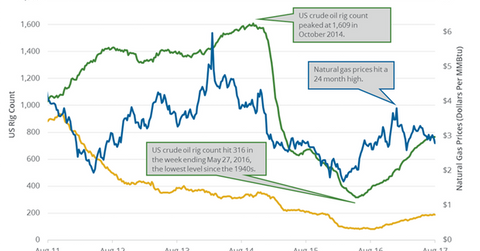Hurricane Harvey Could Impact the US Natural Gas Rig Count
Baker Hughes reported that the US natural gas rig count fell by two to 180 on August 18–25, 2017. It’s the lowest level since May 19, 2017.
Sept. 1 2017, Published 11:39 a.m. ET

US natural gas rig count
On September 1, 2017, Baker Hughes (BHI) will release its US crude oil and natural gas rig count report. In the previous report, Baker Hughes reported that the US natural gas rig count fell by two to 180 on August 18–25, 2017. It’s the lowest level since May 19, 2017.
If the momentum continues, the US natural gas rig count could also fall for the week ending September 1, 2017. US natural gas rigs are slowing due to lower crude oil (RYE) (VDE) and natural gas (UGAZ) (UNG) prices in the last few months.
Lower natural gas prices have a negative impact on drillers and producers’ earnings like Rice Energy (RICE), Exco Resources (XCO), Baker Hughes (BHI), Rowan Companies (RDC), and Diamond Offshore (DO).
US monthly drilling productivity report
The U.S. Energy Information Administration estimates that US natural gas production in the seven shale regions would rise by 929 Mcf (million cubic feet) per day to 59,426 Mcf per day in September 2017—compared to August 2017.
However, drilling activity could have been hampered due to Hurricane Harvey. Production in the Eagle Ford Shale region is offline due to the hurricane. According to a Wall Street Journal survey, 500,000 bpd (barrels per day) of oil production capacity is offline in the Eagle Ford Shale region.
Monthly international rig count
Baker Hughes’s international oil and gas rig count doesn’t include data from the US and Canada. It estimates that international oil and gas rigs fell by one to 959 in July 2017—compared to the previous month. International oil and gas rigs fell 0.1% month-over-month but rose 2.2% YoY (year-over-year).
International natural gas rigs rose 1.5% or by three to 201 in July 2017—compared to the previous month. The rigs are at the same level as July 2016.
Impact
US natural gas rigs are near a four-month low. It suggests that oil and gas rigs could remain range bound unless crude oil and natural gas prices rise again.
In the next part, we’ll discuss US natural gas production.
